|
TURF-TEC DIGEST FOR GOLF COURSE SUPERINTENDENTS AND SPORTS TURF MANAGERS |
|
By: John Mascaro Volume 9 Number 1 – March 2003 |
In this issue:
Editor's notes
Well I must say that I have been doing quite a bit of traveling and between the Sports Turf Managers Association National Show in San Antonio, Texas and the Golf Course Superintendents Show in Atlanta, Georgia, I must have seen about a thousand people over the past two months. Talk about sensory overload! Well I must admit it was quite enjoyable as well, between strolling down the river walk in San Antonio (although for a person from Florida I must say shivering my way along the river walk) and fending off constant outdoorsmen in Atlanta, I had a great time and both were great gatherings. The shows were both well attended and packed with much useful information.
One thing that still amazes me is that with the thousands of people that do attend these shows, they all have a common desire to learn more about their job and improve the turfgrass areas that are under their supervision. Constantly, whether I am attending an educational session or teaching one, it never ceases to amaze me the number of people there to learn.
That is why it is hard for me to understand the reluctance of some employers to send superintendents or sports turf managers to conferences and trade shows. Talk about upper management being short sighted. Attendees to these show pick up so many time saving and labor saving ideas as well as many ways to stretch dollars that the investment of a club or municipality comes back ten fold with each show.
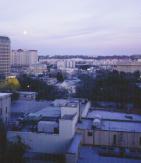 I think employers should not only support, but insist their employees attend at least one conference and trade show each year. I also applaud the people that bring their greens chairman or city managers to at least one educational session, whether it's on a local level or a national level, to show them what these trade associations are all about. If the people in charge of spending could ever grasp how much money educational sessions save them, they should write a personal check out to cover the expenses of these meetings. Let's start a concerted effort to teach our bosses the importance of these conferences and trade shows so we can not only have more and more attendees, but advance our profession into the 21st century.
I think employers should not only support, but insist their employees attend at least one conference and trade show each year. I also applaud the people that bring their greens chairman or city managers to at least one educational session, whether it's on a local level or a national level, to show them what these trade associations are all about. If the people in charge of spending could ever grasp how much money educational sessions save them, they should write a personal check out to cover the expenses of these meetings. Let's start a concerted effort to teach our bosses the importance of these conferences and trade shows so we can not only have more and more attendees, but advance our profession into the 21st century.
I would never aerify!!!
Here is an excerpt from an article in "Golf Digest" written by David Owen entitled "The Greenskeeper's Tale". The complete article link is found below.
The article is speaking about a "greenskeeper" that sounds like a cross between Old Tom Morris and Bill Murray, named
 "Bob"; "At the beginning of the inspection, the USGA agronomist, who was quite young, gave a brief introductory speech, during which Bob took many shallow puffs on his cigar. Then the agronomist turned to Bob and asked, "How often do you aerify your greens?" Aerification is a standard golf-course maintenance procedure. A machine that looks a little like an enormous lawn mower is used to punch thousands of holes in each putting surface. The holes permit air to circulate among the roots of the grass, and they help to eliminate thatch, which is a spongy accumulation of dead material that blocks air flow and promotes disease. Many superintendents aerify their greens twice a year."
"Bob"; "At the beginning of the inspection, the USGA agronomist, who was quite young, gave a brief introductory speech, during which Bob took many shallow puffs on his cigar. Then the agronomist turned to Bob and asked, "How often do you aerify your greens?" Aerification is a standard golf-course maintenance procedure. A machine that looks a little like an enormous lawn mower is used to punch thousands of holes in each putting surface. The holes permit air to circulate among the roots of the grass, and they help to eliminate thatch, which is a spongy accumulation of dead material that blocks air flow and promotes disease. Many superintendents aerify their greens twice a year."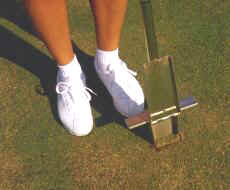 metal scoop attached to one end. He walked over to the old part of the practice green, near which we had been sitting, and plunged the scoop into the putting surface. He pulled it back out, flipped open a metal gate on the side of the scoop and revealed a soil sample that was roughly the size and shape of a slice of wedding cake. The earth in the sample was as black as espresso grounds. Dangling from the bottom, like the tentacles of a jellyfish, was a mass of filamentous roots.
metal scoop attached to one end. He walked over to the old part of the practice green, near which we had been sitting, and plunged the scoop into the putting surface. He pulled it back out, flipped open a metal gate on the side of the scoop and revealed a soil sample that was roughly the size and shape of a slice of wedding cake. The earth in the sample was as black as espresso grounds. Dangling from the bottom, like the tentacles of a jellyfish, was a mass of filamentous roots. http://www.golfdigest.com/features/index.ssf?/features/gd200302greenkeeper2.html
The above article has gotten the attention of many Golf Course Superintendents and been discussed on their web site on the turfgrass forum. To find the forum, go to the website at http://www.gcsaa.org and log on, then click the community tab and click on forum, "Talking it over".
I have a unique perspective on aerification since it was my father that invented the "Aerifier". The aerifier is simply stated a way to re-introduce air into the pore spaces in the root zone after it is depleted by compaction. When the pore space of a soil reach a certain percentage (ideally anything less then 50%), the soil needs to be opened up and air needs to be re-introduced into the soil.
It never ceases to amaze me that one small article written for golfers can cancel out over 70 years of turfgrass research. Now I don't know "Bob" or what his maintenance practices are but you can be sure of one thing, the phrase "other cultural practices" are fairly important and should not be glossed over as was done in this article.
There are many factors that affect the need for aerification; soil composition is probably number one which boils down into several factors like particle size, particle shape, sand, silt and clay percentage, compaction and infiltration. To really answer the question, can you grow good quality turfgrass without aerification? Sure, most areas in nature where turfgrass grow naturally never get aerified. The real question is, can you grow healthy quality grass on a turfgrass area that receives foot traffic, vehicle traffic and wear? Perhaps, and I could probably show you how, however, "Bob" would have to come over and baby sit the grass for you. If Bob is not available, I suggest that you keep an Infiltrometer close by as well as a Moisture Sensor and a Penetrometer.
The fact of the matter is that you can adjust the amount of air pore space in the soil with irrigation water, to create the perfect environment for turfgrass roots. However the soil physical characteristics better be just right, or you better have your resume up to date.
Penetrometer - To determine soil compaction.
Moisture Sensor - For soil moisture content
Infiltrometer - Infiltration rate and pore space.
Brass Sieves - Soil physical characteristics.
Los Angeles Country Club Renovates Greens, Gets Rave Reviews.
The following is a letter from Bruce R. Williams from the Los Angeles Country Club explaining his clubs new renovations. Thanks again Bruce for sharing your experiences with my newsletter readers.
Date: Wed, 19 Feb 2003 14:54:06 -0800
Subject: New Greens
Good morning!
I had to write and tell you about the great changes we made to the greens at our golf club. We spent over a million dollars redoing our greens. At first I was against the project because of the cost. But after a closer look at the plans, I voted in favor of the changes.
Boy am I glad I did. These new greens have lowered my handicap by a ton of strokes. I have no problem shooting in the 70's every time I tee it up. Before, I would three putt several times every round. Not anymore!
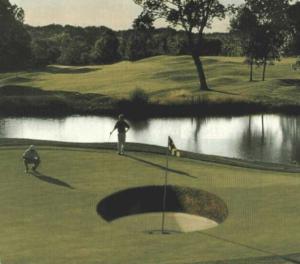 Furthermore, I was ready to go out and buy a new putter. Now I don't have to. The old one works just fine. In addition, I have found new life from my chipper.
Furthermore, I was ready to go out and buy a new putter. Now I don't have to. The old one works just fine. In addition, I have found new life from my chipper.
Here is a photo of our 9th green. It should give you a good idea of what our greens now look like. I'm sure you will able to see the richness of new grass and how short we are able keep it (12.5 on the Stimp). I find I am confident that I can drop a putt from about any place on our greens.
I cannot remember the name of the guy who did our new greens, but I cannot say enough about him. If you want to know his name drop me a line and I will check with our greens superintendent and get back to you.
See you on the greens soon!
BRW
Hey, that's my grass!
There are two types of turf managers in this business, those who know the health of their grass and those that wish they did.
As users of diagnostic tools, you are obviously among the turf managers who know the health of their turf. I have developed all of our diagnostic tools to accomplish one goal, to determine the overall health of your soil.
Grass is simple to grow, in fact, in nature it grows without any care at all. However, we do not live in an untouched "natural world". Our turf is subjected to wear in the form of play and wear in the form of maintenance. Regular foot traffic and vehicle traffic, utility vehicles, mowers and golf carts all lead to outside pressure being put on the soil and grass plant. All of these additional factors are not reproduced in nature and thus grass is not subjected to the same circumstances and wear.
Diagnostic tools give you the edge. In my opinion, if a turfgrass manager knows the things that are vital to their turfgrass health; they will never be surprised by the health of their turf. Key elements like root depth, infiltration, soil moisture and compaction all
come into play to allow you to know the health of your soil and ultimately your grass.
We really have no control over the wear our grass is subjected to unless we install electric fences around our playing areas. We are, however, in control over the wear from maintenance to some degree and that is why we do certain practices like changing mowing directions and limiting maintenance traffic to certain areas. The one variable we have almost total control over is turfgrass health. Regular monitoring is key to determining overall soil and grass health.
The best way to find out how if you are monitoring your turfgrass health properly is to ask yourself "How and I sleeping?" If you ever lay awake in bed and wonder about your turf's health you are missing one of our diagnostic tools. I know that the soundest sleepers exist if they know their root depth, soil compaction, soil infiltration and moisture content. If all these variables are in check, what could possibly be left to remain awake about?
Product tie in:
Mascaro Profile Sampler - Physical characteristics of the soil.
Penetrometer - Soil compaction.
Infiltrometer - Soil infiltration and pore space.
Moisture Sensor - Soil moisture percentage.
Looking back.
The USGA Green Section is one of the assets our nation has for turfgrass research and funding. The following was written by ALEXANDER M. RADKO, Former director of the USGA Green Section and is little retrospect of the USGA Green section. This originally appeared in the October 1978 issue of the Green Section Record.
In 1917, Dr. C. V. Piper and Dr. R. A. Oakley published their book Turf for Golf Courses. Piper and Oakley were U.S. Department of Agriculture scientists who were stationed at the Arlington (Va.) Research Station, now the site of the Pentagon. E. J. Marshall, a Toledo attorney, a member of Inverness Club and apparently influential in other areas, brought the U.S. Department of Agriculture and the U.S. Golf Association together. Dr. Piper agreed to serve as Chairman of the Green Section while he was head of the agronomy section of the USDA Research Station. It was the beginning of an organized approach to solving turfgrass problems on golf courses in this country. Subsequently, all Green Section research results were reported in the Green Section’s first official publication known as The Bulletin of the Green Section of the United States Golf Association. This publication was the first Green Section periodical.
From 1920 through 1953, the Green Section conducted Field Days for anyone Interested In turfgrass culture. Many golf course superintendents attended and benefited from research conducted at the USDA Research Station at Arlington, VA. and at Beltsville, MD. Through these years, the Green Section was in large part responsible for setting maintenance guidelines for golf courses throughout the nation.
In 1932, Dr John Monteith, then the Green Section Director, published Turf Diseases and Their Control, a classic study in turfgrass pathology. While controls have since changed, his description of the various symptoms associated with golf course diseases remains a classic reference. In 1946, the Green Section initiated a bermuda-grass research project with Dr. Glenn Burton at the Georgia Coastal Experiment Station. As a result, the Tifton series of Bermudagrass hybrids were introduced to golf and were widely used throughout the world where Bermudagrass can be grown. These Tifton varieties greatly improved playing conditions and putting surfaces in particular, throughout the southern United States and were responsible in no small measure for the increased interest and participation in golf throughout the South.
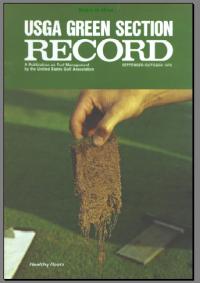 In 1950. the United States Golf Association, in cooperation with the U S Department of Agriculture, after many years of research, released Merion bluegrass (B-27) as an improved Kentucky bluegrass. This was a major step in turfgrass improvement, and it made a tremendous impact upon the turfgrass industry.
In 1950. the United States Golf Association, in cooperation with the U S Department of Agriculture, after many years of research, released Merion bluegrass (B-27) as an improved Kentucky bluegrass. This was a major step in turfgrass improvement, and it made a tremendous impact upon the turfgrass industry.
Merion bluegrass, was one of the Green Sections proudest developments and cooperation w/the the USDA, exhibits the low-growing, dense shoot production that made it an outstanding bluegrass and set the standard by which all Kentucky blue-grasses were subsequently rated.
In 1953, the USGA started offering the Turfgrass Advisory Service where-by an agronomist trained in golf turfgrass culture would visit the course, discuss problems with the golf course superintendent and the green committee chairman and make his recommendations in a written report. This effort has been very successful for the USGA and allows them to be in direct contact with their member courses and clubs.
The USGA Green Section is also the developer of the most widely accepted and utilized putting green construction specifications in the world.
To find current information on the USGA Green Section, visit their website at: http://www.usga.org/green/index.html
One for the funny bone.
And you think your course has strict policy?
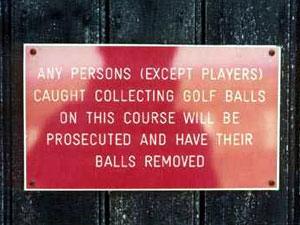
The Moisture Sensor on TV!
Do you watch TV Golf? If your answer is "yes", you have seen the Turf-Tec Moisture Sensor in use. The Professional Golfers Association (PGA) Tour has endorsed the Turf-Tec Moisture Sensor as a "recommendation" on their "Course Conditioning Guidelines" that assist the Golf Course Superintendent in tournament preparation.
The PGA Tour has determined that regular monitoring of soil moisture not only produces superior turfgrass health, but also insures uniformity of all greens and consistency in regards to firmness and ball bounce.
Once superintendents have a Moisture Sensor, they realize it's versatility and usefulness. The advantage of actually being able to put a "number on the moisture" contained within the soil on a green gives a new sense of control over one of the most utilized practices on the course, irrigation.
For those of you that do not yet have a Moisture Sensor, it is a tool that is adjustable to read soil moisture at every inch level in the soil profile from one inch to four inches deep. The read out is immediate and tells the percentage of soil moisture that is in the air space within the soil.
The Moisture Sensor does several things for you; below they are rated by popularity.
So many superintendents tell me that the Moisture Sensor is such a useful tool that I always reply, "I know, I wouldn't grow turfgrass without one". The fact of the matter is, as I mentioned in other parts of this newsletter, the porosity of your soil is directly affected by the amount of moisture within it. If pore space is low (compaction is high) and soil moisture is high, grass health can quickly decline. Finding the right balance for your turfgrass areas is key to having healthy grass.
Too often pore space within the soil profile is filled with moisture and turfgrass roots cannot survive under water. By monitoring soil moisture and keeping air and water in balance, it is amazing how healthy turfgrass can become.
Product tie in:
Moisture Sensor - Determine soil moisture.
I still need pictures for John
Mascaro's Photo Quiz in GCM!
In every monthly issue of "Golf Course Management Magazine" there is a feature called "John Mascaro's Photo Quiz" located on page 26. The feature has two turfgrass related photographs that you are asked to identify as well as some clues about location. The correct answer appears in the back of the magazine. It is informative as well as fun. If any of my newsletter readers ever come across anything different or out of the ordinary, please let me know. If I use the photograph in the magazine, you will get full credit! You can send photographs to: John Mascaro, 3669 NW 124th Avenue, Coral Springs, FL. 33065 or email to john@turf-tec.com
Sports Turf News
STMA National Conference and Show
The Sports Turf Managers Association had their national show in January 2003 in San Antonio, TX. It was an excellent opportunity to see many educational sessions. There was excellent attendance a huge trade show and good food. I met many new people and we had an excellent tour of area stadiums and athletic fields. These pictures are located on my website at: http://www.turf-tec.com/year03-01.html
STMA Members Forum.
There is a new feature on the Sports Turf Managers website called the "Members Forum". This question and answer forum for Members of the STMA National is an excellent way to get questions answered and also find out what works for other sports turf managers. To find the forum, go to the website at http://www.sportsturfmanager.com and then click the tab in the upper right corner to logon. Once you have logged on you should go to # 2 in the STMA Top Five called "Member Forum Q & A".
GCSAA - Golf Course News
Golf Course Superintendents Association National Conference and Show
The Golf Course Superintendents Association of America had its national show in February 2003 in Atlanta, GA.
It was an excellent opportunity to see many educational sessions and the trade show had over 700 exhibitors. I really enjoyed meeting lots of new people and hearing feedback on the Photo Quiz in Golf Course Management. All those people that said that they would send me pictures, please remember to do so.
Turf-Tec website news.
Year In Review Pictures Updated
I have updated my "Year in Review Section" of my website by adding over 40 more photographs of places and of course soil profile samples. These pictures span from July 2002 to February 2003. http://www.turf-tec.com/year02-02.html Some of the places shown are as follows:
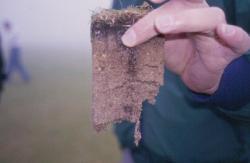 Please
look at these new photographs. If you have never my virtual photo tour, I am
sure you will enjoy it. The photo's date from 1999 to present and have many
different areas and events I have been fortunate enough to see and photograph.
Please
look at these new photographs. If you have never my virtual photo tour, I am
sure you will enjoy it. The photo's date from 1999 to present and have many
different areas and events I have been fortunate enough to see and photograph.
There are over 100 photographs and descriptions to match each one.
Online Ordering
Turf-Tec International offers secure online ordering on our website for those of you that want to pay for orders with credit cards. We accept Visa, MasterCard, Discover and American Express. To try this feature out click here: http://www.turf-tec.com/orderform.html
Find anything on my site!
Since I now have over 120 pages of information, photographs, tours and product literature on my website, I have added a search engine tool on my site. Simply click here http://www.turf-tec.com/collection/search.html or the box that says "Turf-Tec Search" that appears on every page and type the words that you are looking for. The results will be listed in order of relevance in a list form.
Contributions to this publication.
I also want to invite all of you recipients of this newsletter that if you wish to contribute any information that you find interesting or exciting, please send it to me and I will include it along with crediting its source.
Also, if you know another Golf Course Superintendent or Sports Turf Manager that would like to receive the Turf-Tec Digest, have them forward their email address along to me. In addition, I get most of my new product ideas from Golf Course Superintendents and Sports Turf Managers who see a need in the industry that has not been filled. Be sure to look at the new product section on my web site for new additions. http://www.turf-tec.com/Map.html
Privacy policies.
If you received this newsletter directly from john_mascaro@turf-tec.com, don’t worry. I personally acquired your name by researching each golf course and sports facility individually. In addition Turf-Tec does not buy, sell, trade or share their mailing list with anyone. We also have taken security measures to insure that your name will not be passed along to other people. If, however you still do not want to receive this newsletter, simply respond to this email with the words "remove" in the subject line and your name will be permanently deleted from our list.
If you have not received your new free 2003
Turf-Tec Catalog call us.
Our toll free (800) 258-7477 or email me at john@turf-tec.com or fill out the online form at http://www.turf-tec.com/form.html
![]()
1471 Capital Circle NW, Suite # 13
Tallahassee, FL. 32303
Order Line (800) 258-7477
Phone (850) 580-4026
Fax (850) 580-4027
Home / Search Site / Catalog
/ Online Ordering / Map of site / Newsletter
On line consult / Contact us
History / Web Designs / Request Catalog /
Search Engines
Copyright 2003